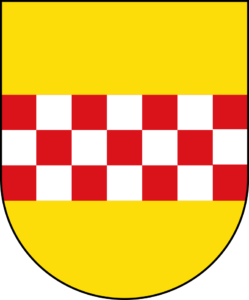County of Mark (State of the Holy Roman Empire)

The County of Mark is a region in the western part of the Holy Roman Empire. It is a territory of great significance, as it lies at the crossroads of many important trade routes and is home to numerous towns and villages.
- Coat of arms/Flag – The coat of arms of the County of Mark is a black eagle with a red tongue and claws, standing on a golden background. The flag of the county is a black and gold banner.
- Motto – The motto of the County of Mark is “Avito viret honore”, which translates to “It flourishes with ancestral honor”.
- Status – The County of Mark is a state within the Holy Roman Empire, ruled by the House of La Marck.
- General Alignment – Neutral
- Capital City- The capital city of the County of Mark is Mark, which is located in the northwestern part of the state.
- Other Settlements – Other notable settlements within the County of Mark include Hamm, Iserlohn, and Lüdenscheid.
- Common languages – The most common language spoken in the County of Mark is German, some also speak Dutch.
- Religion(s) – The primary religion of the County of Mark is Roman Catholicism.
- Demographics – The County of Mark is home to a diverse population of farmers, craftsmen, and merchants. There is also a small nobility class that rules over the county.
- Government – The government of the County of Mark is a feudal system, with the Count of Mark as the highest authority.
- Legislature – The legislature of the County of Mark is made up of the Count and his advisors.
- Population – The population of the County of Mark is estimated to be around 100,000 people.
- Places of interest – The County of Mark is known for its many castles, including the Castle of Altena and the Castle of Hohensyburg. Other notable places of interest include the St. Mary’s Church in Iserlohn and the St. John’s Church in Lüdenscheid.
- Current Ruler – The current ruler of the County of Mark is Count John III of La Marck.
- Other Notable residents – Other notable residents of the County of Mark include the merchant Johann von Lünen and the knight Heinrich von Kleve.
- Notable places – Some of the most notable places in the County of Mark include the Castle of Altena, the Castle of Hohensyburg, and the St. Mary’s Church in Iserlohn.
The County of Mark is located in the western part of the Holy Roman Empire, bordering the Rhine river to the west and the Sauerland hills to the east. The landscape is a mix of dense forests, rolling hills, and fertile river valleys. The region is known for its abundant natural resources, including timber, coal, and iron. Many of the towns and villages in the County are centered around mining and manufacturing industries.
The people of the County of Mark are a mix of Germans and Frisians, with their own unique customs and traditions. The common language spoken in the region is Low German, although many people also speak High German and some also speak Dutch. The primary religion in the area is Roman Catholicism, although there is also a significant Protestant minority.
While the County of Mark is generally peaceful, there are stories of mythical creatures that roam the forests and hills. Some say that there are trolls that dwell in the mountains, while others claim that there are creatures known as “Wild Huntsmen” who ride through the forests at night. Despite these tales, the people of the County of Mark continue to go about their daily lives, working the land and trading with their neighbors.
In terms of governance, the County of Mark is ruled by a Count who is appointed by the Holy Roman Emperor. The Count is responsible for maintaining law and order in the region, and overseeing the various towns and villages that make up the County. The region has a rich history and is home to many important landmarks and places of interest, including castles, cathedrals, and marketplaces.
In summary, the County of Mark is a vital and bustling region in the western part of the Holy Roman Empire. It is home to a diverse population and a mix of industries, all of which contribute to the economic and cultural richness of the region.

 Buy me a coffee
Buy me a coffee